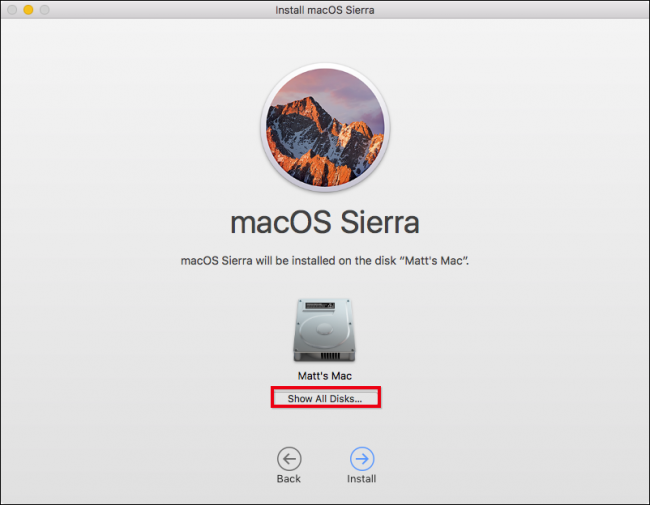

- #Format external hard drive mac high sierra how to#
- #Format external hard drive mac high sierra install#
- #Format external hard drive mac high sierra update#
- #Format external hard drive mac high sierra driver#
- #Format external hard drive mac high sierra password#
In addition, be sure that you know all of your online account passwords and logins - for this, a password manager like 1Password can be very useful. Make sure that you have access to all installation media for your apps (developer websites, Mac App Store, DVD or CD), and it’s a good idea to make a Note of all apps that you wish to re-install.
#Format external hard drive mac high sierra update#
Clean installs are also useful if a software or system software update has somehow trashed your existing operating system or if you have replaced a hard drive.īe sure you have plenty of time available to complete the complete install, as it can sometimes take as much as a day to go through all the steps.Īs noted, we’re going to completely erase everything on the Mac.
#Format external hard drive mac high sierra install#
In many cases, a clean install can improve the performance of a sluggish Mac. The idea behind a clean install is to start with a completely bare machine, getting rid of any old data, files, preferences, settings, old drivers, apps you no longer use, and so on.
#Format external hard drive mac high sierra how to#
In this post, we’ll describe how to do a clean install of macOS 10.13 High Sierra.īefore we get started, make a decision as to whether you want to do a regular update or a clean install, because a regular update is much easier to perform than a clean install. What’s a clean install? That means that the hard drive is erased completely and reformatted, which removes not only the current Mac operating system but all data, files, applications, you name it… Just think of it as a brand new computer having the operating system installed on it for the first time. The Ball is indeed in your court.Sometimes it’s a good idea to do a clean install of a new Mac operating system version. Simply put, you can enable write operations on NTFS drive even when there is a possibility of data loss. Looks Simple, no? Also, watch this video to get a better understanding. Just connect the drive, scan it, preview the recoverable files and save them. Stellar Phoenix Mac Data Recovery – Professional works in a way that no other tool can match. In addition, operating it is quite easy as in a few simple steps you can perform data recovery on macOS High Sierra (NTFS drive). You can deploy Stellar Phoenix Mac Data Recovery - Professional to resume things to normal. Having a Mac data recovery is another option that can be considered for restoring deleted files.

More important, your data is at risk if anything goes haywire hence, backup your data before proceeding with it. While implementing commands in Terminal may seem quick and easy, it has some pitfalls like occasional instability, security risks, etc. Unmount the connected NTFS drive and again plug it into your Mac to access the files on the drive with write operations. Save the file (Press Ctrl + O) and Ctrl + X to close the Terminal I. Launch Terminal and enter the following command On the contrary, it may wreak havoc on your Mac’s stability causing issues with your File System (corrupt data issue).īefore proceeding with this step, make sure that the NTFS external drive is mounted on your Mac. However, there is no guarantee that it will work. You need to get into your troubleshooting mode and feed command lines to get it done. To enable NTFS write on Mac, you need to mess with the Terminal. Feeding some magical command lines in the Terminal: Vii. Enable System Integration Protection and reboot your Mac to perform write operations to the NTFS external drive.ģ. Sudo ln -s /usr/local/sbin/mount_ntfs /sbin/mount_ntfs

Sudo mv /sbin/mount_ntfs /sbin/mount_ntfs.original Vi. After disabling System Integration Protection, link NTFS-3G to the system location by typing the following command:
#Format external hard drive mac high sierra driver#
Now disable System Integration Protection to replace the NTFS driver with NTFS-3G and reboot your Mac Iv. Next, type in the following commands to install OSXFUSE and NTFS-3G *(Homebrew cask is extends Homebrew package manager which makes it easier to install and manage graphical applications) Type in brew install caskroom/cask/brew-cask command to install Homebrew cask. Enter the following command in the Terminal prompt: Got to Applications folder, open the Utilities folder and launch Terminal *(You need to temporarily disable System Integrity Protection first to replace default read-only NTFS driver with NTFS-3G)įollow these instructions to install NTFS-3G: Besides, enabling write support to NTFS drives on Mac is a security risk as well. They are slower and just not that powerful as compared with the paid versions. Free and open source utilities are also an option to access NTFS external drives on your macOS High Sierra enabled Mac.


 0 kommentar(er)
0 kommentar(er)
